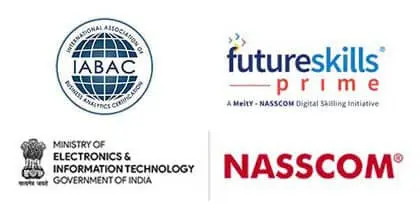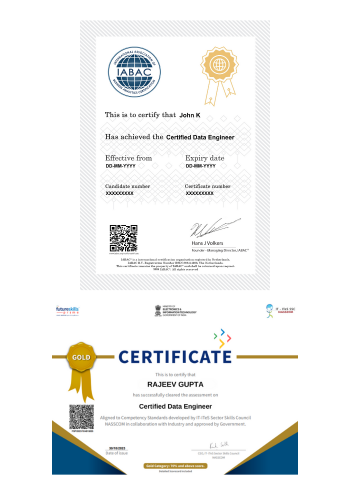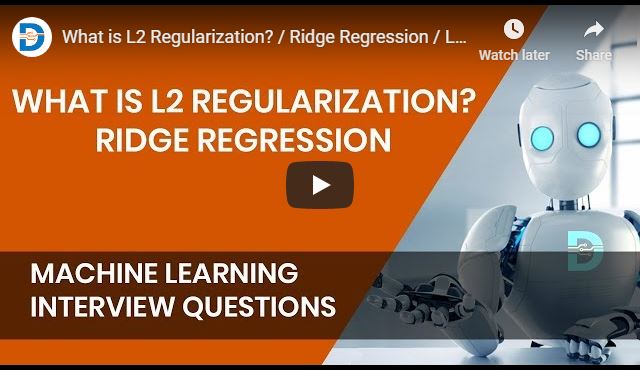Instructor Led Live Online
Self Learning + Live Mentoring
In - Person Classroom Training
The entire training includes real-world projects and highly valuable case studies.
IABAC® certification provides global recognition of the relevant skills, thereby opening opportunities across the world.
MODULE 1: DATA ENGINEERING INTRODUCTION
• What is Data Engineering?
• Data Engineering scope
• Data Ecosystem, Tools and platforms
• Core concepts of Data engineering
MODULE 2: DATA SOURCES AND DATA IMPORT
• Types of data sources
• Databases: SQL and Document DBs
• Managing Big data
MODULE 3: DATA INTEGRITY AND PRIVACY
• Data integrity basics
• Various aspects of data privacy
• Various data privacy frameworks and standards
• Industry related norms in data integrity and privacy: data engineering perspective
MODULE 4: DATA ENGINEERING ROLE
• Who is a data engineer?
• Various roles of data engineer
• Skills required for data engineering
• Data Engineer Collaboration with Data Scientist and other roles.
MODULE 1: PYTHON BASICS
• Introduction of python
• Installation of Python and IDE
• Python objects
• Python basic data types
• String functions part
• String functions part
• Python Operators
MODULE 2: PYTHON CONTROL STATEMENTS
• IF Conditional statement, IF-ELSE
• NESTED IF
• Python Loops Basics, WHILE Statement
• BREAK and CONTINUE statements
• FOR statements
MODULE 3: PYTHON PACKAGES
• Introduction to Packages in Python
• Datetime Package and Methods
MODULE 4: PYTHON DATA STRUCTURES
• Basic Data Structures in Python
• Basics of List
• List methods
• Tuple: Object and methods
• Sets: Object and methods
• Dictionary: Object and methods
MODULE 5: PYTHON FUNCTIONS
• Functions basics
• Function Parameter passing
• Lambda functions
• Map, reduce, filter functions
MODULE 1 : OVERVIEW OF STATISTICS
• Introduction to Statistics: Descriptive And Inferential Statistics
• a.Descriptive Statistics
• b.Inferential Statistis
• Basic Terms Of Statistics
• Types Of Data
MODULE 2 : HARNESSING DATA
• Random Sampling
• Sampling With Replacement And Without Replacement
• Cochran's Minimum Sample Size
• Types of Sampling
• Simple Random Sampling
• Stratified Random Sampling
• Cluster Random Sampling
• Systematic Random Sampling
• Multistage Sampling
• Sampling Error
• Methods Of Collecting Data
MODULE 3 : EXPLORATORY DATA ANALYSIS
• Exploratory Data Analysis Introduction
• Measures Of Central Tendencies, Measure of Spread
• Data Distribution Plot: Histogram
• Normal Distribution
• Z Value / Standard Value
• Empherical Rule and Outliers
• Central Limit Theorem
• Normality Testing
• Skewness & Kurtosis
• Measures Of Distance: Euclidean, Manhattan And Minkowski Distance
• Covariance and Correlation
MODULE 4 : HYPOTHESIS TESTING
• Hypothesis Testing Introduction
• Types of Hypothesis
• P- Value, Crtical Region
• Types of Hypothesis Testing: Parametric, Non-Parametric
• Hypothesis Testing Errors : Type I And Type II
• Two Sample Independent T-test
• Two Sample Relation T-test
• One Way Anova Test
• Application of Hypothesis Testing (Proposed)
MODULE 1: DATA WAREHOUSE FOUNDATION
• Data Warehouse Introduction
• Database vs Data Warehouse
• Data Warehouse Architecture
• Data Lake house
• ETL (Extract, Transform, and Load)
• ETL vs ELT
• Star Schema and Snowflake Schema
• Data Mart Concepts
• Data Warehouse vs Data Mart —Know the Difference
• Data Lake Introduction architecture
• Data Warehouse vs Data Lake
MODULE 2: DATA PROCESSING
• Python NumPy Package Introduction
• Array data structure, Operations
• Python Pandas package introduction
• Data structures: Series and DataFrame
• Importing data into Pandas DataFrame
• Data processing with Pandas
MODULE 3: DOCKER AND KUBERNETES FOUNDATION
• Docker Introduction
• Docker Vs.VM
• Hands-on: Running our first container
• Common commands (Running, editing,stopping,copying and managing images)YAML(Basics)
• Publishing containers to DockerHub
• Kubernetes Orchestration of Containers
• Docker swarm vs kubernetes
MODULE 4: DATA ORCHESTRATION WITH APACHE AIRFLOW
• Data Orchestration Overview
• Apache Airflow Introduction
• Airflow Architecture
• Setting up Airflow
• TAG and DAG
• Creating Airflow Workflow
• Airflow Modular Structure
• Executing Airflow
MODULE 5: DATA ENGINEERING PROJECT
• Setting Project Environment
• Data pipeline setup
• Hands-on: build scalable data pipelines
MODULE 1 : AWS DATA SERVICES INTRODUCTION
• AWS Overview and Account Setup
• AWS IAM Users, Roles and Policies
• AWS S overview
• AWS EC overview
• AWS Lamdba overview
• AWS Glue overview
• AWS Kinesis overview
• AWS Dynamodb overview
• AWS Athena overview
• AWS Redshift overview
MODULE 2 : DATA PIPELINE WITH GLUE
• AWS Glue Crawler and setup
• ETL with AWS Glue
• Data Ingesting with AWS Glue
MODULE 3 : DATA PIPELINE WITH AWS KINESIS
• AWS Kinesis overview and setup
• Data Streams with AWS Kinesis
• Data Ingesting from AWS S using AWS Kinesis
MODULE 4 : DATA WAREHOUSE WITH AWS REDSHIFT
• AWS Redshift Overview
• Analyze data using AWS Redshift from warehouses, data lakes and operations DBs
• Develop Applications using AWS Redshift cluster
• AWS Redshift federated Queries and Spectrum
MODULE 5 : DATA PIPELINE WITH AZURE SYNAPSE
• Azure Synapse setup
• Understanding Data control flow with ADF
• Data Pipelines with Azure Synapse
• Prepare and transform data with Azure Synapse Analytics
MODULE 6 : STORAGE IN AZURE
• Create Azure storage account
• Connect App to Azure Storage
• Azure Blob Storage
MODULE 7: AZURE DATA FACTORY
• Azure Data Factory Introduction
• Data transformation with Data Factory
• Data Wrangling with Data Factory
MODULE 8 : AZURE DATABRICKS
• Azure databricks introduction
• Azure databricks architecture
• Data Transformation with databricks
MODULE 9 : AZURE RDS
• Creating a Relational Database
• Querying in and out of Relational Database
• ETL from RDS to databricks
MODULE 10 : AZURE RDS
• Hands-on Project Case-study
• Setup Project Development Env
• Organization of Data Sources
• AZURE/AWS services for Data Ingestion
• Data Extraction Transformation
MODULE 1: GIT INTRODUCTION
• Purpose of Version Control
• Popular Version control tools
• Git Distribution Version Control
• Terminologies
• Git Workflow
• Git Architecture
MODULE 2: GIT REPOSITORY and GitHub
• Git Repo Introduction
• Create New Repo with Init command
• Copying existing repo
• Git user and remote node
• Git Status and rebase
• Review Repo History
• GitHub Cloud Remote Repo
MODULE 3: COMMITS, PULL, FETCH AND PUSH
• Code commits
• Pull, Fetch and conflicts resolution
• Pushing to Remote Repo
MODULE 4: TAGGING, BRANCHING AND MERGING
• Organize code with branches
• Checkout branch
• Merge branches
MODULE 5: UNDOING CHANGES
• Editing Commits
• Commit command Amend flag
• Git reset and revert
MODULE 6: GIT WITH GITHUB AND BITBUCKET
• Creating GitHub Account
• Local and Remote Repo
• Collaborating with other developers
MODULE 1 : DATABASE INTRODUCTION
MODULE 2 : SQL BASICS
MODULE 3 : DATA TYPES AND CONSTRAINTS
MODULE 4 : DATABASES AND TABLES (MySQL)
MODULE 5 : SQL JOINS
MODULE 6 : SQL COMMANDS AND CLAUSES
MODULE 7 : DOCUMENT DB/NO-SQL DB
MODULE 1: BIG DATA INTRODUCTION
• Big Data Overview
• Five Vs of Big Data
• What is Big Data and Hadoop
• Introduction to Hadoop
• Components of Hadoop Ecosystem
• Big Data Analytics Introduction
MODULE 2: HDFS AND MAP REDUCE
• HDFS – Big Data Storage
• Distributed Processing with Map Reduce
• Key Terms: Output Format
• Partitioners Combiners Shuffle and Sort
• Hands-on Map Reduce task
MODULE 3: PYSPARK FOUNDATION
• PySpark Introduction
• Resilient distributed datasets (RDD),Working with RDDs in PySpark, Spark Context , Aggregating Data with Pair RDDs
• Spark Databricks
• Spark Streaming
MODULE 1: SPARK SQL and HADOOP HIVE
• Introducing Spark SQL
• Spark SQL vs Hadoop Hive
• Working with Spark SQL Query Language
MODULE 2: KAFKA and Spark
• Kafka architecture
• Kafka workflow
• Configuring Kafka cluster
• Operations
MODULE 3: KAFKA and Spark
• Creating an HDFS cluster with containers
• Creating pyspark cluster with containers
• Processing data on hdfs cluster with pyspark cluster
MODULE 1: TABLEAU FUNDAMENTALS
• Introduction to Business Intelligence & Introduction to Tableau
• Interface Tour, Data visualization: Pie chart, Column chart, Bar chart.
• Bar chart, Tree Map, Line Chart
• Area chart, Combination Charts, Map
• Dashboards creation, Quick Filters
• Create Table Calculations
• Create Calculated Fields
• Create Custom Hierarchies
MODULE 2: POWER-BI Basics
• Power BI Introduction
• Basics Visualizations
• Dashboard Creation
• Basic Data Cleaning
• Basic DAX FUNCTION
MODULE 3: DATA TRANSFORMATION TECHNIQUES
• Exploring Query Editor
• Data Cleansing and Manipulation:
• Creating Our Initial Project File
• Connecting to Our Data Source
• Editing Rows
• Changing Data Types
• Replacing Values
MODULE 4: CONNECTING TO VARIOUS SOURCES
• Connecting to a CSV File
• Connecting to a Webpage
• Extracting Characters
• Splitting and Merging Columns
• Creating Conditional Columns
• Creating Columns from Examples
• Create Data Model
Data engineering is the practice of designing, developing, and managing systems and processes that facilitate the efficient handling and analysis of large amounts of data. Its primary objectives include establishing reliable data pipelines, ensuring data quality and integrity, and enabling data-driven decision-making.
To pursue a career in data engineering in Allahabad, individuals should consider the following actions:
Build a strong knowledge base in mathematics, statistics, and programming.
Acquire proficiency in programming languages like Python or SQL.
Develop expertise in database management systems and data manipulation techniques.
Familiarize themselves with big data technologies like Hadoop and Spark.
Enhance their skills through hands-on projects and practical experience.
Enrolling in data engineer training provides numerous benefits, such as:
Acquiring sought-after skills and knowledge in the field of data engineering.
Improving job prospects across diverse industries.
Gaining practical experience through hands-on projects and real-world applications.
Staying updated with the latest industry trends and advancements.
Absolutely, data engineering has a bright future ahead. As organizations increasingly rely on data for decision-making and the volume of data continues to grow rapidly, the demand for proficient data engineers is projected to remain high. Data engineering is essential in efficiently managing and processing data to extract valuable insights and support business success.
To join a data engineer training in Allahabad, individuals typically need to meet certain qualifications, which can vary depending on the course and institution. Generally, having a basic understanding of mathematics, statistics, and programming is beneficial. Knowledge of databases, SQL, and programming languages such as Python or Java can also be advantageous.
The price range for data engineer training in Allahabad typically varies based on factors such as the institution, duration of the program, and mode of delivery (online or classroom). Generally, the fees can range from around 40,000 INR to 1,00,000 INR.
DataMites is highly renowned as an institute that provides exceptional data engineer training. Their offerings include a comprehensive curriculum, industry-relevant projects, and experienced instructors who equip students with the essential skills in data engineering.
Upon completing data engineer training, individuals can explore diverse career prospects, including roles such as Data Engineer, Database Administrator, ETL Developer, Big Data Engineer, and Cloud Data Engineer. These opportunities span across industries such as technology, finance, healthcare, and e-commerce.
Yes, it is possible for individuals with no prior experience to secure data engineer job positions. Entry-level roles or positions as junior data engineers are often available for individuals without extensive experience. Additionally, gaining practical experience through internships or projects can also provide opportunities to enter the field.
Data engineer training holds great significance as it equips individuals with the skills and knowledge needed to thrive in the field. It encompasses vital concepts, tools, and techniques essential for constructing data pipelines, managing databases, and ensuring effective data processing and analysis. This expertise is invaluable in today's data-driven landscape, where organizations heavily rely on data for decision-making and achieving business success.
To obtain data engineering training in Allahabad, individuals can follow the process of enrolling at DataMites. DataMites offers comprehensive courses that cover essential data engineering concepts, tools, and techniques. With a strong emphasis on hands-on experience, practical projects, and guidance from experienced instructors, DataMites ensures individuals in Allahabad acquire the necessary skills in data engineering.
The DataMites Certified Data Engineer Training program in Allahabad encompasses a diverse range of topics, including data engineering concepts, tools, and technologies such as Hadoop, Spark, SQL, and data pipeline development. The program also incorporates practical exercises and hands-on projects to enhance your skills in these areas.
The Data Engineer Course at DataMites® in Allahabad welcomes applications from individuals who meet certain eligibility criteria. Generally, those with a background in computer science, mathematics, or related fields, as well as professionals interested in pursuing data engineering careers, are eligible to apply.
The duration of the DataMites Data Engineer Course in Allahabad typically varies based on the learning mode chosen. On average, online instructor-led training lasts for approximately 6 months, consisting of over 150 learning hours. However, self-paced learning options may have different durations.
Yes, DataMites® offers classroom training for Data Engineer courses in Allahabad, along with online training options. They provide flexibility in choosing the training mode that best fits your preferences and schedule.
The Data Engineer Course in Allahabad at DataMites® is conducted by knowledgeable instructors who specialize in data engineering concepts, tools, and industry practices. These instructors provide comprehensive guidance and support throughout the training program.
DataMites® provides a range of training formats for data engineering courses, including instructor-led online training, classroom training, and self-paced learning options. This allows individuals to choose the format that best suits their learning preferences and schedule.
Yes, DataMites® offers the option to attend demo classes without the need to pay the course fee upfront. This enables you to get a glimpse of the teaching methodology, course content, and interact with instructors before making a commitment.
Indeed, DataMites® understands the financial circumstances of learners and offers the flexibility to pay the course fee in installments. This allows individuals to pursue their data engineering training without facing a significant upfront financial burden.
Yes, DataMites® provides Data Engineer Courses in Allahabad with placement assistance. They offer career support, including resume building, interview preparation, and networking with potential employers to help participants secure job opportunities.
The DataMites Placement Assistance Team(PAT) facilitates the aspirants in taking all the necessary steps in starting their career in Data Science. Some of the services provided by PAT are: -
The DataMites Placement Assistance Team(PAT) conducts sessions on career mentoring for the aspirants with a view of helping them realize the purpose they have to serve when they step into the corporate world. The students are guided by industry experts about the various possibilities in the Data Science career, this will help the aspirants to draw a clear picture of the career options available. Also, they will be made knowledgeable about the various obstacles they are likely to face as a fresher in the field, and how they can tackle.
No, PAT does not promise a job, but it helps the aspirants to build the required potential needed in landing a career. The aspirants can capitalize on the acquired skills, in the long run, to a successful career in Data Science.











